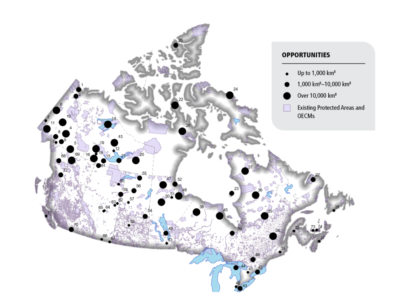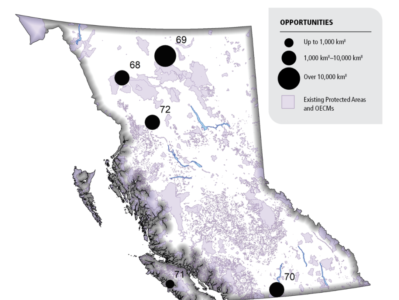Despite global momentum to protect nature, BC government’s inaction remains rigid roadblock
FOR IMMEDIATE RELEASE
June 16, 2022
Despite global momentum to protect nature, BC government’s inaction remains rigid roadblock
Xʷməθkʷəy̓əm (Musqueam), Sḵwx̱wú7mesh (Squamish) and səlilwətaɬ (Tsleil-Waututh) Territories / Vancouver, BC —
Proposals for land protection—many of which are Indigenous-led—could add nine percent to BC’s protected landbase and help slow the roll on climate change and species loss, according to a new Canadian Parks and Wilderness Society (CPAWS) report1.
The report lays the path for BC to protect at least 30% of lands and waters by 2030. Indigenous Protected and Conserved Areas (IPCAs), provincial parks, and conservancies offer a long-term solution to protect nature and people.
“The math is simple: by upholding proposals for Indigenous-led protection today, the BC Government could secure protection for 30% of its landbase,” says Kevin Barlow, Executive Director at CPAWS-BC. “Indigenous Peoples are still working hard to care for their Territories. It’s time for the BC Government to sit down with First Nations and recognize their conservation visions as a way to move forward on climate and extinction mitigation.”
The report calculates that existing protected area proposals cover 85,000km2, or nine percent, of the province, over two and half times the surface area of Vancouver Island. These proposals include Dene K’éh Kusān—a 39,136km2 wildlife haven in northern BC—as well as the Nuu-Chah-Nulth’s Salmon Parks, which will restore and protect critical wild salmon habitat in Nootka Sound.
In addition, the report makes recommendations to the BC Government to accelerate high-quality land conservation, including committing to 25% and 30% global land protection targets, upgrading BC’s other conserved areas2,3, and developing a legal framework for IPCA recognition and support.
“At their current rate of protection, it will take 145 years for the BC Government to protect 30% of the province,” says Jessie Corey, National Senior Manager, Terrestrial Conservation at CPAWS. “Already, climate events are causing more disease, damage, and death than ever. Nature—and British Columbians—can’t wait that long.”
-30-
For more information, contact:
Rippon Madtha
Communications Manager
604-685-7445 (x 23)
rippon@cpawsbc.org
Resources:
1 Canadian Parks and Wilderness Society. (16 June 2022). Roadmap to 2030: Delivering on Canada’s Land and Ocean Protection Targets[Report]. Retrieved from: www.cpaws.org/roadmapto2030
2 Business in Vancouver. (17 February 2022). B.C. flouting Canadian, international standards on protected areas, says report. [News]. Retrieved from: https://biv.com/article/2022/02/bc-flouting-canadian-international-standards-protected-areas-says-report
3 Canadian Parks and Wilderness Society British Columbia. (February 2022). An Honest Accounting: Improving BC’s Approach to Claiming Other Conserved Areas [Report]. Retrieved from: https://cpawsbc.org/wp-content/uploads/2022/02/22-02-04-OECM-report-%C6%92-reduced-1.pdf
About CPAWS-BC:
The Canadian Parks and Wilderness Society (CPAWS) is Canada’s only nationwide charity dedicated solely to the protection of our public land, ocean, and freshwater, and ensuring our parks and protected areas are managed to protect nature. Since 1963, CPAWS has played a leading role in protecting over half a million square kilometers. Our vision is to protect at least half of Canada’s public land and water in a framework of reconciliation – for the benefit of wildlife and people.
The CPAWS British Columbia chapter (CPAWS-BC) works to protect wilderness in every corner of BC and deep into the ocean. We have been defending BC since 1978, and are dedicated to keeping BC’s natural environment thriving forever. Nature is BC’s best hope.
Follow us! @CPAWSbc




